Abstract
Environmental problems arising from conventional production models have posed a significant challenge in the search for renewable sources as raw materials for the production of everyday chemical compounds through more sustainable alternatives. The objective of the present work was the electrochemical synthesis of organic acids from the liquid of the natural and technical cashew nut shell (CNSLn and CNSLt), employing chronopotentiometry using a potentiostat and a graphite working electrode. Two concentrations (0.01–0.1% v/v) of CNSLn and CNSLt, two concentrations of NaOH as supporting electrolyte (0.125–2 M), and two current densities (40–60 mA/cm2) were tested in the experiments. Organic acids were detected and quantified by HPLC. To characterize the redox processes occurring in the constituents of CNSL, spectroelectrochemical analysis (FTIR–cyclic voltammetry), FTIR, and chronoamperometry were performed. The maximum concentrations obtained in the treatments were: acetic acid (828.86 mg/L), lactic acid (531.78 mg/L), and formic acid (305.4 mg/L), while other acids present in lower concentrations included oxalic, propionic, citric, and malonic acids. Voltammetry characterizations showed three irreversible oxidation processes in the anodic wave during the first cycle, indicating that the first process involved the formation of the phenoxy radical, the second process the formation of hydroquinones and benzoquinones, and the third process the cleavage of the aromatic ring and the aliphatic chain to form the organic acids. Furthermore, another oxidation pathway was observed, consisting of a fourth process in the second voltammetry cycle, corresponding to the nucleation of the phenoxy radical, evidenced as the formation of the C–O–C bond visible at 1050 cm−1 in the infrared spectrum. From this route, a polymer was formed on the electrode surface, which limited the yield of organic acid synthesis. Finally, this research provides new insights in the field of electrochemistry, specifically in the synthesis of organic acids from CNSL as a renewable feedstock, with the novelty being the production of oxalic, propionic, citric, and malonic acids.
1. Introduction
Pollution and the accumulation of waste from various industries have severely affected ecosystems, causing consequences that are sometimes irreversible to both biotic and abiotic components. These situations have resulted in direct and indirect repercussions on human health [,,,]. In response to the above, and in order to address this environmental problem caused by production models involving the use of non-renewable raw materials and production cycles with oxidizing and reducing agents, in recent decades, new sustainable production methods based on renewable and low-cost raw materials have been explored [].
One renewable source that has been widely studied is cashew nut shell liquid (CNSL), due to its alkylphenolic composition, whose properties have been exploited for applications in various industrial, agricultural, medicinal, and other sectors [,,,,,]. Anacardic acid, cardanol, and cardol are the constituents of CNSL, and their proportions vary depending on the CNSL extraction method [].
CNSL is referred to as natural CNSL (CNSLn) when extraction does not involve temperatures above 180 °C, and the proportions of its constituents are: anacardic acid 60–65%, cardanol 10%, cardol 15–20%, and traces of 2-methylcardol. On the other hand, it is called technical CNSL (CNSLt) when extraction involves temperatures between 180–200 °C, generally consisting of cardanol 60–65%, cardol 15–20%, anacardic acid 0–2%, 2-methylcardol 1.2–4.1%, and traces of polymeric material [,].
In addition to studies linking a wide variety of applications of CNSL and its constituents, recent electrochemical research has obtained high-value-added organic acids by applying electrochemical oxidation to effluents containing CNSLt, suggesting that phenolic constituents can be cleaved to synthesize acetic acid, oxalic acid, malonic acid, and other acids [,].
Although effluents from the cashew industry have been treated using electrochemical techniques, with research focusing on the use of BDD, DSA, or Ti/RuO2IrO2TiO2 anodes [,,], there is also the possibility of exploring the direct electrochemical transformation of CNSLn and CNSLt using more accessible electrodes such as graphite electrodes, aiming to contribute new knowledge in this field, specifically oriented toward renewable, sustainable, and technically viable production.
Moreover, in Colombia, the cashew agroindustry sector shows an annual production growth of 7% []. This has also led to an increase in discarded waste such as shells and/or effluents, generating environmental concerns, as CNSL is a pollutant whose lethal doses and concentrations have already been studied in mammals and aquatic fauna [,]. Additionally, in rural areas of the departments of Sucre and Córdoba, this agroindustry depends on seasonal harvesting, and the waste generated from the shelling process receives no treatment or valorization as an alternative source of income due to limited access to technological alternatives.
Based on the ideas presented, this research focuses on the transformation of CNSLn and CNSLt through electrochemical techniques as a conversion and characterization mechanism, testing conditions that allow the study of performance patterns, thereby contributing to the utilization and reduction of this type of waste, to the renewable production of organic acids, and to the advancement of this field in the long term as an alternative that could impact rural economies by diversifying their income through science, technology, and innovation.
2. Results and Discussion
The electrochemical experiment using chronopotentiometry resulted in the synthesis of the following organic acids: citric acid, propionic acid, malonic acid, oxalic acid, lactic acid, formic acid, and acetic acid, which were detected and quantified by HPLC (Figure 1).
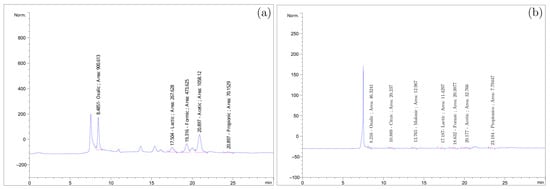
Figure 1.
(a) HPLC experiment 1; (b) HPLC experiment 32.
Acetic, formic, and oxalic acids have already been reported from the treatment of effluents using CNSLt as a raw material in Medeiros et al. [,]. It is important to note that the electrochemical treatment of CNSLn and CNSLt had not been previously reported, and the novelty of this work lies in the synthesis of propionic, malonic, lactic, and citric acids from CNSL.
The concentrations of these organic acids varied according to specific experimental conditions. Therefore, conditions that yielded a high-performance pattern for the respective organic compounds were selected. These yields were calculated based on the initial mass of CNSL. It is worth highlighting that lactic acid, formic acid, and acetic acid showed the highest synthesis concentrations, while the other detected organic acids were produced in lower concentrations, as shown in Table 1.

Table 1.
Organic acids synthesized by electrosynthesis.
The results suggest that there are specific conditions that directly affect the production of the main organic acids, with notable yields found for acetic acid (828.86 mg/L; 82.9%), lactic acid (531.78 mg/L; 53.2%), and formic acid (305.24 mg/L; 30.5%), while yields for the other organic acids did not exceed 11%, calculating the maximums for citric acid (33.88 mg/L; 3.39%), propionic acid (109.65 mg/L; 10.97%), malonic acid (17.46 mg/L; 1.75%) and oxalic acid (106.85 mg/L; 10.69%), For these organic acids that were obtained in lower concentrations, further studies should analyze the possible optimization for their synthesis. The results showed the selectivity of citric acid at lower concentrations of CNSLn (0.01% v/v), NaOH (0.125 M) and 40 mA/cm2, propionic acid obtained its highest concentration when using CNSLt (0.1% v/v), NaOH (0.125 M) and 40 mA/cm2, malonic acid was selective to CNSLt (0.1% v/v), Na2SO4 (0.125 M) and 40 mA/cm2, and oxalic acid obtained its maximum concentration when applying CNSLt (0.1% v/v), Na2SO4 (2 M) and 60 mA/cm2, these synthesis values show a different behavior to the predominant organic acids that were mostly selective to the use of high concentrations of NaOH (2 M).
Based on these results, a simplified table was created showing the conditions that led to the most optimal production yields (Table 2).

Table 2.
Production yields of acetic, formic, and lactic acids.
The results establish a relationship between the type and concentration of CNSL, the electrolyte concentration, and the applied current density for the production of organic acids. In the case of CNSLt, the maximum concentrations of acetic acid were reached at 2 M electrolyte concentration, 0.1% v/v CNSL, and 60 mA/cm2 current density, similarly to CNSLn under the same conditions, with CNSLt showing more promise for this organic acid.
Regarding formic acid, the highest concentrations were obtained with CNSLn, suggesting a probable selectivity of the compound depending on the type of CNSL used. For lactic acid, the maximum concentrations were achieved with CNSLt, particularly when the current density was lower (40 mA/cm2).
The results suggest that increasing the NaOH concentration enhances the production of organic acids. This relationship arises because the increase in electrolyte concentration not only improves the system’s conductivity but also dissolves the CNSL []. As the electrolyte concentration increases, a greater proportion of CNSL molecules are dissolved and thus become susceptible to oxidation.
An increase in current density can promote a higher oxidation rate on the electrode surface and simultaneously a greater cleavage of the constituents [,], although undesired reactions such as polymerization may occur, compromising the synthesis yield of organic acids [].
In the chronopotentiograms (Figure 2), the potential behavior under different experimental conditions was observed. In most cases, voltage fluctuations characterized by an increase and decrease in electrode resistance are evident; this phenomenon is attributed to the delayed electron transfer kinetics at the surface. At this point, polymeric layers form as coatings that occupy active reaction sites, consequently leading to low organic acid production yields [,].
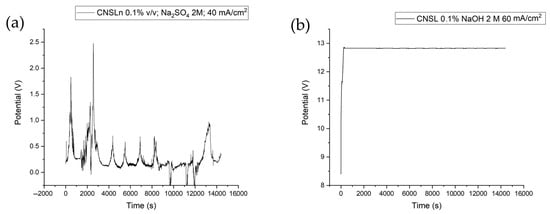
Figure 2.
(a) Chronopotentiogram of experiments: NaOH 0.125 M, CNSLn 0.1% v/v, 60 mA/cm2; (b) NaOH 2 M, CNSLn 0.1% v/v, 60 mA/cm2.
However, under the condition of CNSLt 0.1%, NaOH 2 M, and a current density of 60 mA/cm2, a stable behavior is observed, and it is precisely under this condition that the highest acetic acid production is expressed, with a yield value of 82.9%.
2.1. Spectroelectrochemical Analysis
Cyclic voltammetry showed that the constituents of CNSL are not conductive by themselves at pure concentrations, requiring the addition of a supporting electrolyte (NaOH 0.125 M) to carry out the process (Figure 3). The CNSL constituents exhibited a common behavior characterized by the presence of three irreversible oxidation processes and the formation of a loop in the anodic wave (Figure 3).
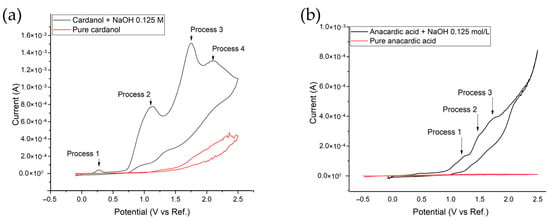
Figure 3.
(a) Cyclic voltammetry of cardanol (b) anacardic acid at one cycle.
These oxidation processes govern the transformations of cardanol and anacardic acid during electrosynthesis. The first process corresponds to the formation of the phenoxy radical, the second to the formation of hydroquinones and benzoquinones, and in the third oxidation process, the aromatic ring opens, giving rise to hydrocarbon chains that are subsequently cleaved to form organic acids [,]. These processes are schematically illustrated below (Figure 4).
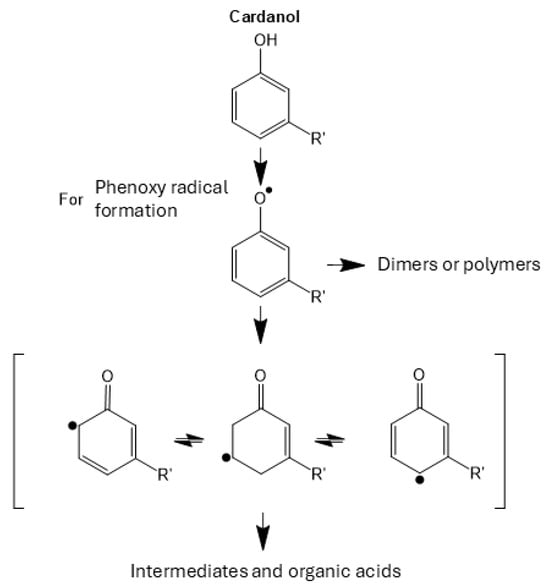
Figure 4.
Oxidation processes of cardanol during the first cycle.
The oxidation could be evidenced by a change in the infrared spectrum of cardanol, also observed in anacardic acid by Arrieta et al., 2025 []. The first oxidative peak appears as a low-intensity peak in the region around 1050 cm−1 (Figure 4), indicative of the presence of carboxylates (C–O–C) [,]. This corresponds with the loop observed in the previous voltammogram and suggests nucleation of the phenoxy radical. This oxidation pathway leads to the formation of dimers or polymers.
The second oxidative process manifests as a change in the region near 1698 cm−1, associated with C=C vibrations of the aromatic ring. As the reaction proceeds, the intensity of the C=C bond peak decreases, suggesting the formation of intermediates such as ethyl derivatives and aliphatic hydrocarbons produced by the cleavage of the aromatic ring (Figure 5).
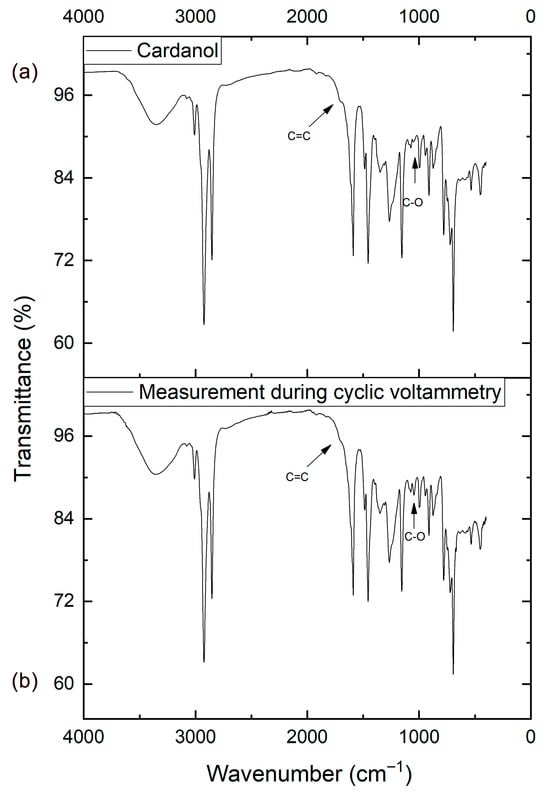
Figure 5.
(a) Spectrum of cardanol and during cyclic voltammetry (b).
On the other hand, the phenomena observed in the spectrum and voltammogram allowed a more detailed study of the oxidation processes of the constituents by applying 10 scan cycles at 20 mV/s. The results of this characterization are shown for both constituents, displaying similar behavior (Figure 6).
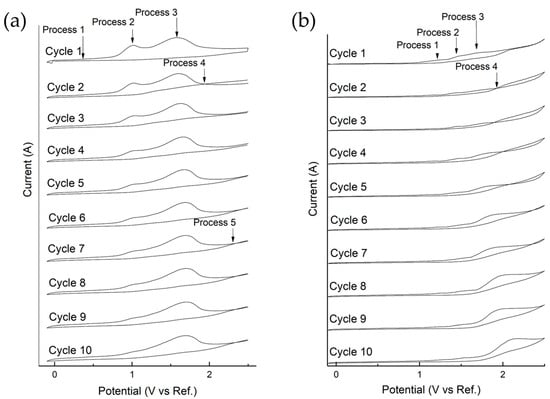
Figure 6.
(a) Cyclic Voltammetry—Cardanol, (b) Anacardic Acid at 20 mV/s and 10 scan cycles.
Referencing the study on anacardic acid by Arrieta et al., 2025 [], and in this case for cardanol, three irreversible oxidation processes are observed in the anodic wave during the first cycle. For cardanol, the first process occurs at 0.4 V, leading to the formation of the phenoxy group by the loss of hydrogen from the phenol’s OH group. Subsequently, the second oxidation process occurs at 1.01 V, producing hydroquinones and benzoquinones, and the third oxidation process, occurring at 1.57 V, involves the cleavage of intermediates to form low molecular weight organic acids [,,], it should be noted that organic acids can react with the alcohols formed in the electrosynthesis process, forming ethyl and methyl esters, which react with OH radicals, causing the cleavage of the esters into organic acids, CO2, and H2O. Oxidative processes in general for this type of compound mainly generate carboxylic acids [,].
In the second cycle, a loop forms at 1.94 V, which corresponds to the nucleation of phenoxy radicals []. These radicals undergo oligomerization or polymerization, evidenced by the coating formed on the electrode surface. It can be observed how the nucleation loop shifts toward more positive potentials in subsequent cycles, disappearing by the fifth cycle at 2.47 V (in anacardic acid, it disappears by the sixth cycle).
The shift in nucleation possibly indicates progressive polymerization and changes in the electrode’s surface properties, which affect the nucleation potential and the yield of the electrochemical synthesis. Again, in the seventh cycle, a new nucleation appears, which could be related to phenoxy radicals that have not yet been consumed, forming polymeric material once more.
Based on the voltammogram studies, these phenomena were expressed in a diagram representing the reactions occurring during the electrochemical oxidation process of CNSL constituents (Figure 7), applying the cyclic voltammetry potentials described above. Some studies have proposed that the formed oligomers or polymers can undergo oxidations that degrade them into CO2 and H2O []. However, in several conducted experiments, no polymer degradation was observed. At the end of the electrooxidation process, for CNSLn, the polymer appeared as a copper-colored crust, while for CNSLt, the polymers were characterized by a thin coating on the electrode surface.
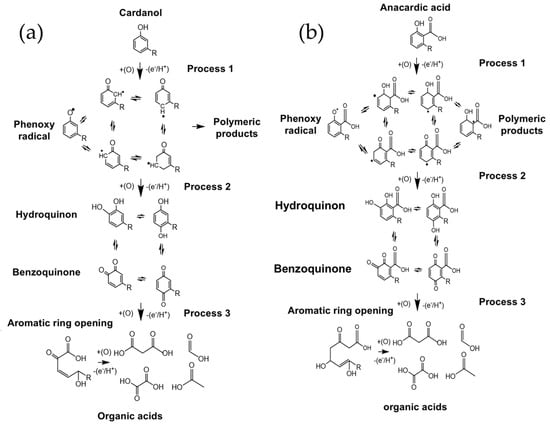
Figure 7.
Scheme of the oxidation reactions of (a) cardanol and (b) anacardic acid, into low molecular weight organic acids and polymeric material.
These electropolymerization processes have been studied previously, with polymerization proceeding through the phenoxy radical via consecutive addition reactions [,].
To verify that the constituents decompose into organic acids as shown in the schemes (Figure 7), electrochemical synthesis was carried out using anacardic acid and cardanol, the major constituents in CNSLn and CNSLt, respectively. The experiment was performed by chronopotentiometry under conditions similar to the CNSL treatment, as outlined in Table 3.

Table 3.
Synthesis of organic acids from cardanol and anacardic acid.
2.2. Infrared Spectroscopy Characterization
The characterized material corresponded to the polymeric layers formed on the working electrode surface. It was observed that in experiments with CNSLt, these layers appeared as a thin, dark-colored coating, unlike the experiments with CNSLn, which exhibited a copper-colored crust (Figure 8).
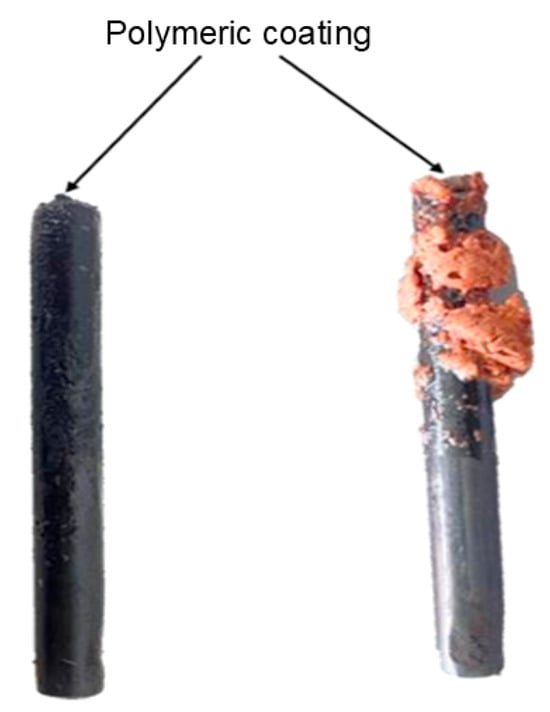
Figure 8.
Polymeric material as a coating on: cardanol (left) and anacardic acid (right).
The polymeric material derived from CNSLt that coats the electrode was characterized by a dark color. Infrared measurements revealed peaks corresponding to CNSLt, highlighting a peak in the 1040 cm−1 region attributed to the C–O group (Figure 9), which is the nucleation point for the formation of this type of polymer through the oxidation pathways previously described [,,].

Figure 9.
Infrared spectrum: (a) cardanol; (b) polymeric material.
On the other hand, the polymeric material derived from CNSLn in the infrared spectrum shows the functional groups of anacardic acid (Figure 10). It also exhibits a peak in the 1046 cm−1 region corresponding to the C–O bond. These types of polymers pose limitations for the formation of organic acids, but they may also represent a research field regarding insulating coatings and their properties.
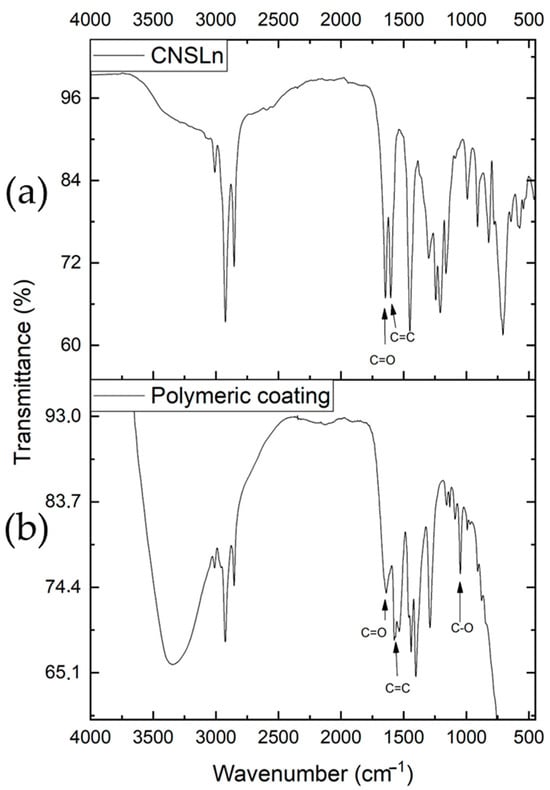
Figure 10.
Infrared spectrum: (a) anacardic acid; (b) polymeric coating.
The electropolymerization of these phenols is influenced by various factors such as monomer concentration, electrolysis parameters, electrode material, and electrolyte type, among others [,]. In this study, the conditions listed in Table 2 suggest they are optimal to minimize the formation of such coatings on the electrode surface. This conclusion is supported by the yields reported earlier (Table 1 and Table 2).
It is important to highlight the use of the graphite electrode, whose porous surface favors the cleavage reactions of organic matter. This characteristic facilitates the diffusion and transport of electrolytes and electroactive species, while providing a greater number of active sites for reactant interaction and reaction, allowing the simultaneous transformation of organic substances []. The high efficiency of the electrode makes it a sustainable resource due to its renewable origin and low acquisition cost, making it an accessible material. Additionally, the established conditions appear promising for scalability and the development of technology based on CNSL as a renewable raw material through electrochemical techniques.
3. Materials and Methods
3.1. Reagents
Natural CNSL (CNSLn) was extracted from cashew nut shells by pressing under ambient temperature and pressure conditions. The cashew nut shell used was from Anacardium occidentale Yucao Ao3 variety provided by the company ASOPROMARSAB (Chinú, Cordoba, Colombia). Technical CNSL (CNSLt) was obtained by thermal treatment of CNSLn at 180–200 °C for 4 h. For electrochemical experiments, the following reagents were used: sodium hydroxide (NaOH; Sigma Aldrich, St. Louis, MO, USA; 99.9%), sodium sulfate (Na2SO4; Sigma Aldrich, St. Louis, MO, USA, 99.9%), ethanol (C2H6O; Merck, Darmstadt, Germany; 99.8%), methanol (CH3OH; Panreac Química S.L.U., Barcelona, Spain; 99.9%), ammonium hydroxide solution (NH3; Sigma Aldrich, St. Louis, MO, USA, 28–30%), hexane (CH3(CH2)4CH3; Merck, Darmstadt, Germany), hydrochloric acid (HCl; Panreac Química S.L.U., Barcelona, Spain; 37%), Celite 545 (Merck, Darmstadt, Germany), calcium hydroxide (Ca(OH)2; Merck, Darmstadt, Germany; 99.9%), ethyl acetate (C4H8O2; Merck, Darmstadt, Germany; 99.8%), and activated carbon.
Cardanol was obtained by liquid–liquid extraction, which consisted of dissolving 50 g of CNSLt in methanol (160 mL) and adding ammonium hydroxide (25%, 100 mL), stirring for 15 min. Extraction was carried out with hexane (4 × 100 mL). The extract was then washed with 5% HCl (50 mL) and subsequently with distilled water (50 mL). Activated carbon (5 g) was added, stirred for 10 min, and filtered through Celite (7.5 g). The filtrate was dried over anhydrous sodium sulfate and concentrated to obtain pure cardanol [].
Anacardic acid was obtained by dissolving 50 g of CNSLn in 200 mL of 5% methanol, then slowly adding 25 g of calcium hydroxide until a precipitated salt (calcium anacardate) was formed. The salt was filtered, washed with distilled water, heated at 45–50 °C for 3 h, and then suspended in a solution of distilled water and 11 M HCl. The acid was then extracted and dried over 17.5 g of anhydrous sodium sulfate [,].
3.2. Electrochemical Synthesis of High-Value-Added Organic Acids
The main organic acids synthesized by electrosynthesis are summarized in Table 4, which presents the experiment consisted of mixing CNSLt or CNSLn (0.01% v/v, 0.1% v/v) in an electrolyte solution composed of 25% ethanol and NaOH (0.125–2 M). A saturated calomel reference electrode, a graphite working electrode, and a platinum counter electrode were connected to a Gamry Interface 1010E potentiostat (Gamry Instruments, Warminster, PA, USA) and immersed in the prepared solution. The applied current densities were 40 mA/cm2 and 60 mA/cm2. The electrochemical experiment lasted approximately 4 h, and the technique employed was chronopotentiometry [].

Table 4.
Experimental conditions for the electrosynthesis of organic acids from natural and technical CNSL.
3.3. Detection of Organic Acids by HPLC
Characterization and quantification were performed using an Agilent 1100 Series High-Performance Liquid Chromatography (HPLC) system with a UV/Vis detector and a SUPELCOGEL H column for organic acid detection (Agilent Inc., Santa Clara, CA, USA). The operating conditions were as follows: Injection volume: 20 μL; Flow rate: 0.5 mL/min; Mobile phase: 0.1% H3PO4 solution.
3.4. Spectroelectrochemical Analysis
This technique was performed by cyclic voltammetry at 10 mV/s using a DropSens 110 screen-printed carbon electrode (Metrohm, Asturias, Spain), with cardanol mixed with NaOH and 25% ethanol in a 4:1 ratio. Simultaneously with cyclic voltammetry, infrared spectra were recorded using a PerkinElmer Spectrum Two IR spectrometer (PerkinElmer Inc., Shelton, CT, USA).
3.5. Cyclic Voltammetry Characterization
Cyclic voltammetry was carried out using a DropSens 110 screen-printed carbon electrode (Metrohm, Asturias, Spain) immersed in a solution of 25% ethanol, 0.125 M NaOH, and anacardic acid or cardanol at a concentration of 0.1% v/v. The voltammetry conditions were as follows: Initial potential: −0.5 V; Final potential: 2.5 V; Scan rate: 20 mV/s; Number of cycles: 10.
4. Conclusions
This study establishes a solid foundation for the development of scalable electrochemical technologies. The efficient and economically competitive production of value-added compounds from cashew nutshell liquid (CNSL) residues depends on the optimization and precise control of CNSL and NaOH concentrations, as well as current density. This technology has the potential to drive industrial advances toward the production of organic acids through a clean, renewable, cost-effective, and innovative model, with a positive impact on the environment and on the diversification of local economies that face technological limitations. In this study, CNSLn showed yields for acetic, formic, and lactic acids, but was more selective for formic acid production, while CNSLt proved more promising for lactic and acetic acid. The organic acids synthesized in lower concentrations are of particular interest for investigating specific conditions that could optimize their production. Thanks to the alkylphenolic structure of CNSL, it is possible to synthesize these compounds via electrochemical oxidation, successfully cleaving its structure into organic acids. This research contributes new knowledge on sustainable applications of CNSL. Finally, it is recommended to consider economic feasibility studies.
Author Contributions
Conceptualization, A.A.A., O.P.C. and J.A.D.; Methodology, A.A.A. and J.A.D.; Validation, A.A.A., O.P.C. and J.A.D.; Formal Analysis, A.A.A., O.P.C. and J.A.D.; Investigation, A.A.A., O.P.C. and J.A.D.; Resources, A.A.A. and O.P.C.; Data Curation, A.A.A., O.P.C. and J.A.D.; Writing—Original Draft Preparation, A.A.A., O.P.C. and J.A.D.; Writing—Review & Editing, A.A.A., O.P.C. and J.A.D.; Project Administration, A.A.A. and J.A.D.; Funding Acquisition, A.A.A., O.P.C. and J.A.D. All authors have read and agreed to the published version of the manuscript.
Funding
This research was funded by Minciencias (Ministry of Science, Technology, and Innovation) with resources from the SGR—General Royalties System—project identified with 2021000100052. The authors also acknowledge the financial support of Fundación Universitaria Los Libertadores (Colombia), project ING-14-25, Universidad de Sucre (Colombia), and Universidad de Córdoba (Colombia).
Institutional Review Board Statement
Not applicable.
Informed Consent Statement
Not applicable.
Data Availability Statement
The original contributions presented in this study are included in the article. Further inquiries can be directed to the corresponding author.
Conflicts of Interest
The authors declare no conflicts of interest.
References
- Brusseau, M.L.; Artiola, J.F. Chemical contaminants. In Environmental and Pollution Science; Academic Press: Cambridge, MA, USA, 2019; pp. 175–190. [Google Scholar]
- Pereira, R.; Díaz-Cruz, M.S.; Barceló, D.; Llorca, M. Human health risk assessment of endocrine disrupting compounds in urban wastewater treatment plants: A comparative study of influent and effluent concentrations in different European countries. Sci. Total Environ. 2019, 685, 556–569. [Google Scholar]
- Baquerizo, M.; Acuña, M.; Solis-Castro, M. Contaminación de los ríos: Caso río Guayas y sus afluentes. Manglar 2019, 16, 63–70. [Google Scholar] [CrossRef]
- Fenga, C.; Gangemi, S.; Costa, C. Health effects of toxicants: Online knowledge support. Interdiscip. Toxicol. 2015, 8, 145–146. [Google Scholar]
- Clark, J.H.; Macquarrie, D. (Eds.) Handbook of Green Chemistry and Technology; John Wiley & Sons: Hoboken, NJ, USA, 2007. [Google Scholar]
- Lubi, M.C.; Thachil, E.T. Cashew nut shell liquid (CNSL)—A versatile monomer for polymer synthesis. Des. Monomers Polym. 2000, 3, 123–153. [Google Scholar] [CrossRef]
- Veeramanoharan, A.; Kim, S.C. A comprehensive review on sustainable surfactants from CNSL: Chemistry, key applications and research perspectives. RSC Adv. 2024, 14, 25429–25471. [Google Scholar] [CrossRef]
- Rojtman, E.; Denis, M.; Sirvent, C.; Lapinte, V.; Caillol, S.; Briou, B. Polyols from Cashew Nutshell Liquid (CNSL), corner-stone building blocks for cutting edge biobased additives and polymers. Polym. Chem. 2024, 15, 4375–4415. [Google Scholar] [CrossRef]
- Gartili, A.; Lapinte, V.; Briou, B.; Caillol, S. Valorization of CNSL as a Sustainable Solution for PVC Plasticization: A Comprehensive Study of Cardanol–Cardol Mixture. J. Am. Oil Chem. Soc. 2025, 102, 1141–1157. [Google Scholar] [CrossRef]
- Preethi, R.; Moses, J.A.; Anandharamakrishnan, C. Development of anacardic acid incorporated biopolymeric film for active packaging applications. Food Packag. Shelf Life 2021, 28, 100656. [Google Scholar] [CrossRef]
- Krishnan, P. Cashew Nut Shell Liquid (CNSL) Based Bio-Derived Resin And Composites for Advanced Structural, Automotive, Electronic Packaging and Medical applications-A Review. Org. Polym. Mater. Res. 2019, 1, 9–13. [Google Scholar] [CrossRef]
- Paramashivappa, R.; Kumar, P.P.; Vithayathil, P.J.; Rao, A.S. Novel method for isolation of major phenolic constituents from cashew (Anacardium occidentale L.) nut shell liquid. J. Agric. Food Chem. 2001, 49, 2548–2551. [Google Scholar] [CrossRef]
- Phani Kumar, P.; Paramashivappa, R.; Vithayathil, P.J.; Subba Rao, P.V.; Srinivasa Rao, A. Process for isolation of cardanol from technical cashew (Anacardium occidentale L.) nut shell liquid. J. Agric. Food Chem. 2002, 50, 4705–4708. [Google Scholar] [CrossRef]
- Rodrigues, F.H.; França, F.C.; Souza, J.R.; Ricardo, N.M.; Feitosa, J. Comparison between physico-chemical properties of the technical Cashew Nut Shell Liquid (CNSL) and those natural extracted from solvent and pressing. Polímeros 2011, 21, 156–160. [Google Scholar] [CrossRef]
- Medeiros, M.C.; dos Santos, E.V.; Martinez-Huitle, C.A.; Fajardo, A.S.; Castro, S.S. Obtaining high-added value products from the technical cashew nut shell liquid using electrochemical oxidation with BDD anodes. Sep. Purif. Technol. 2020, 250, 117099. [Google Scholar] [CrossRef]
- Medeiros, M.; de Medeiros, J.; Martinez-Huitle, C.; Oliveira, T.; Mazzetto, S.; da Silva, F.; Castro, S.S. Long-chain phenols oxidation using a flow electrochemical reactor assembled with a TiO2-RuO2-IrO2 DSA electrode. Sep. Purif. Technol. 2021, 264, 118425. [Google Scholar] [CrossRef]
- Medeiros, M.C.; Castro, S.S.; dos Santos, E.V.; Rodrigo, M.A.; Martínez-Huitle, C.A. A proof of concept for the electro-refinery: Selective electroproduction of acetic acid from t-CNSL waste by using DSA electrode. Electrochem. Commun. 2022, 141, 107356. [Google Scholar] [CrossRef]
- Orduz-Rodríguez, J.O.; Rodríguez-Polanco, E. El marañón (Anacardium occidentale L.) un cultivo con potencial productivo: Desarrollo tecnológico y perspectivas en Colombia. Agron. Mesoam. 2022, 33, 47268. [Google Scholar] [CrossRef]
- Martins, R.I.; Beatriz, A.D.; Santaella, S.T.; Lotufo, L.V. Ecotoxicological analysis of cashew nut industry effluents, specifically two of its major phenolic components, cardol and cardanol. Pan-Am. J. Aquat. Sci. 2009, 4, 363–368. [Google Scholar]
- Sahoo, A.; Ghosh, A.; Dey, A.; Maji, S.; Das, S.; Sultana, I.; Chattopadhyay, S. Assessment of Oxidative Liver Injury Caused by Cashew Nut Shell Liquid (CNSL) via Interacting with Bcl2 Gene in Male Wistar Rats and Basic In-silico Approaches. In Proceedings of the Zoological Society; Springer: New Delhi, India, 2024; Volume 77, pp. 136–146. [Google Scholar]
- Stiefel, S.; Marks, C.; Schmidt, T.; Hanisch, S.; Spalding, G.; Wessling, M. Wessling, Overcoming lignin heterogeneity: Reliably characterizing the cleavage of technical lignin. Green Chem. 2016, 18, 531–540. [Google Scholar] [CrossRef]
- Dos Santos, A.J.; De Lima, M.D.; Da Silva, D.R.; Garcia-Segura, S.; Martínez-Huitle, C.A. Influence of the water hardness on the performance of electro-Fenton approach: Decolorization and mineralization of Eriochrome Black T. Electrochem. Acta 2016, 208, 153–163. [Google Scholar] [CrossRef]
- Alfonta, L.; Bardea, A.; Khersonsky, O.; Katz, E.; Willner, I. Chronopotentiometry and Faradaic impedance spectroscopy as signal transduction methods for the biocatalytic precipitation of an insoluble product on electrode supports: Routes for enzyme sensors, immunosensors and DNA sensors. Biosens. Bioelectron. 2001, 16, 675–687. [Google Scholar] [CrossRef]
- Zhao, C.; Wang, J. Electrochemical reduction of CO2 to formate in aqueous solution using electro-deposited Sn catalysts. Chem. Eng. J. 2016, 293, 161–170. [Google Scholar] [CrossRef]
- Arrieta, A.A.; Ducuara, J.A.; Nuñez de la Rosa, Y. Study of Electrochemical Transformation of Anacardic Acid from Cashew (Anacardium occidentale) Nut Shell Liquid. Molecules 2025, 30, 1330. [Google Scholar] [CrossRef] [PubMed]
- Larkin, P.J.; Jackson, A. Interpretation of the Infrared Spectra of Metal Stearate Salts. Appl. Spectrosc. Pract. 2024, 2, 27551857241253834. [Google Scholar] [CrossRef]
- Smith, B.C. The Carbonyl Group, Part V: Carboxylates—Coming Clean. Spectroscopy 2018, 33, 20–23. [Google Scholar]
- Xue, Y.; Hu, X.; Sun, Q.; Wang, H.-Y.; Wang, H.-L.; Hou, X.-M. Review of electrochemical degradation of phenolic compounds. Int. J. Miner. Metall. Mater. 2021, 28, 1413–1428. [Google Scholar] [CrossRef]
- Maia, F.; Clemente, C.; Oliveira, T.; Lomonaco, D.; Oliveira, T.; Almeida, M.; De Lima, P.; Correia, A.; Mazzeto, S. Electrochemical and computational studies of phenolic antioxidants from cashew nut shell liquid. Electrochim. Acta. 2012, 79, 67–73. [Google Scholar] [CrossRef]
- Tasic, Z.; Gupta, V.K.; Antonijevic, M.M. The mechanism and kinetics of degradation of phenolics in wastewaters using electrochemical oxidation. Int. J. Electrochem. Sci. 2014, 9, 3473–3490. [Google Scholar] [CrossRef]
- Ziyatdinova, G.; Guss, E.; Yakupova, E. Electrochemical sensors based on the electropolymerized natural phenolic antioxidants and their analytical application. Sensors 2021, 21, 8385. [Google Scholar] [CrossRef]
- Enache, T.A.; Oliveira-Brett, A.M. Phenol and para-substituted phenols electrochemical oxidation pathways. J. Electroanal. Chem. 2011, 655, 9–16. [Google Scholar] [CrossRef]
- Tahar, N.B.; Savall, A. Electropolymerization of phenol on a vitreous carbon electrode in alkaline aqueous solution at different temperatures. Electrochim. Acta 2009, 55, 465–469. [Google Scholar] [CrossRef]
- Saravanan, G. Porous Carbon Materials for Electrochemical Energy Storage. Int. J. Energetic Mater. 2018, 4, 13–16. [Google Scholar]
Disclaimer/Publisher’s Note: The statements, opinions and data contained in all publications are solely those of the individual author(s) and contributor(s) and not of MDPI and/or the editor(s). MDPI and/or the editor(s) disclaim responsibility for any injury to people or property resulting from any ideas, methods, instructions or products referred to in the content. |
© 2025 by the authors. Licensee MDPI, Basel, Switzerland. This article is an open access article distributed under the terms and conditions of the Creative Commons Attribution (CC BY) license (https://creativecommons.org/licenses/by/4.0/).